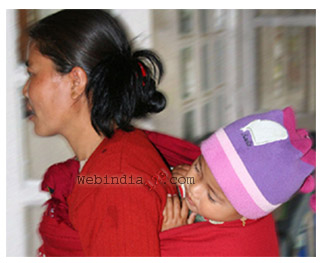People
 There is not much of historical evidence available on
the origin of the people of Manipur. There are different schools of thought
regarding the origin. Some people considered Manipuris as the descendants
of Tartar Colony from China. Others considered that the Manipuris were
descendants of the surrounding hill tribes i.e. the big race of Nagas
which was once in existence in many parts of the world. The Manipuris
are related to the present Naga race of the hills also in respect of many
customs still in existence in both groups. Some believe that Manipuris
are a fine stalwart race descended from an Indo-Chinese stock, with some
admixture of Aryan blood. Some scholars consider that the Manipuris are
Kshatriyas as mentioned in the Epic, 'Mahabharatha'. Another school of
thought consider Manipuris the descendants of Kiratas. The distribution
of Kiratas in north-eastern region is one of the evidences to support
this school of thought. Another school of thought considers Manipuris
to be descended from the stock of Dravidians who migrated from south India
to Manipur and Naga hills through Burma. There is not much of historical evidence available on
the origin of the people of Manipur. There are different schools of thought
regarding the origin. Some people considered Manipuris as the descendants
of Tartar Colony from China. Others considered that the Manipuris were
descendants of the surrounding hill tribes i.e. the big race of Nagas
which was once in existence in many parts of the world. The Manipuris
are related to the present Naga race of the hills also in respect of many
customs still in existence in both groups. Some believe that Manipuris
are a fine stalwart race descended from an Indo-Chinese stock, with some
admixture of Aryan blood. Some scholars consider that the Manipuris are
Kshatriyas as mentioned in the Epic, 'Mahabharatha'. Another school of
thought consider Manipuris the descendants of Kiratas. The distribution
of Kiratas in north-eastern region is one of the evidences to support
this school of thought. Another school of thought considers Manipuris
to be descended from the stock of Dravidians who migrated from south India
to Manipur and Naga hills through Burma.
The population of Manipur comprises different social groups. They are
Meiteis, Nagas, Kukis and Miscellaneous groups. The entire population
of Manipur is distributed into two regions: the hill population and the
valley population. The valley people are supposed to be the descendants
of four old tribes called Khuman, Luang, Moirang and Maithai. The hill
people are broadly divided into Naga and Kuki tribes. The people of Manipur,
both in the valley and the hills are having predominantly Mongoloid features.
But it is not difficult to distinguish the valley and the hill people.
The people from the valley show a developed sharpness in their features
over their hill counter-parts. The valley population had numerous occasions
to come in contact with the invaders and migrants through the valley.
This contact over the ages regenerated a race of some peculiar characteristics,
in physical features reflecting the basic Mongoloid characters with definite
modifications, to a certain degree.
The concept of unity in diversity
was a remarkable characteristic of this state. In the history of Manipur there has not been even a single
instance of communal or ethnic dispute. But in recent times, Manipur has been
the scene of bitter ethnic conflict. The ethnic animosity between the
Kukis and the Nagas stems from xenophobic insecurity. Over 1,000 have been
killed, more injured, houses burnt down and thousands rendered homeless, in the
conflicts in the past six years.
The people of Manipur are
simple and largely
untouched by the pollution of modern living. Their wants are few, they love
outdoor life, find communion with nature and depend on the gifts of nature like
rice for food, fish to supplement their dish. The general facial characteristic
of the Manipuris are of the Mongolian type. There is a great diversity of the features among them.
The people are very good
looking and fair. It is not uncommon to meet girls with
brownish black hair, brown eyes, fair complexions, straight noses and rosy cheeks.
The
Manipuris are decidedly a muscular race. Fat people are rare. They have good chests and well formed limbs.
The Meitei language,
which is the official state language is
basically the language of the valley people and other dialects spoken by the tribes
in the hills are classified under Tibeto-Burman family. Meitei language
have been borrowed by the Naga and Kuki people of the hills.
The majority population of the entire state is under the
religious fold of Hinduism especially in the valley. There is
no trace of Buddhism having been established here in any period of history.
Islam entered through the Muslim migrants from East Bengal, but Muslim
population in the valley is very little. Christianity, introduced by the British as a policy was not embraced by Meiteis
in the valley but attracted almost entire hill tribes.
|

